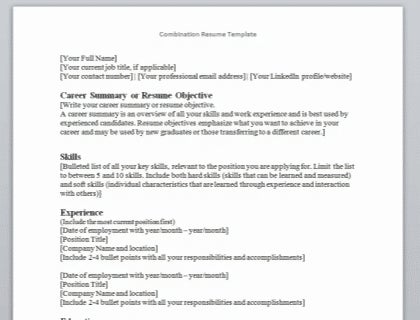When Should You Use a Combination Resume?
When a position requires both qualifications as well as practical experience, this format is a good choice. Because the combination resume lists skills, experience, achievements, and qualifications, it provides greater freedom, meaning you can be more selective about what you choose to include or not, and also what you decide to highlight.
How to Write a Combination Resume:

Regardless of the type of resume format you choose, there are basic guidelines you'll need to follow. For the best results, read through our step-by-step guide on how to write a combination resume.
Create a combination resume.
List your name and contact details first.

Always use a professional email address and a reliable contact number, and include your LinkedIn profile or any links to websites relevant to your work.
Add a career summary.

Include a career summary or resume objective beneath your contact details. A Career Summary may be better suited to the Combination Resume, as this format is for those with extensive experience.
Showcase your skills.

Start by listing your most important skills. Include both hard and soft skills, limiting the section to between five and ten points.
Include your education history.

Include your education history, starting with the most recently obtained qualifications. Include any degrees, diplomas, or certificates that are relevant to the position you are applying for. Also provide details on any accomplishments or contributions you've made while completing your qualifications.
Highlight your career milstones.

Lastly, include any awards or achievements that you would like to highlight in a separate section right at the bottom of your resume.
Tips for Writing a Combination Resume:
- Be extra selective when deciding what to include in your Combination Resume. Don't get carried away and cram all your work experience, qualifications, and skills onto one page. Include only the aspects of your career you believe the hiring manager would be most interested in.
- Choose a font like Times New Roman, Arial, or Helvetica. Use only black and font size 10 to 12. You may bold the headings.
- Do not use color or fancy graphics and be mindful to remove them if you are using resume builder.
- Do not include false information on your resume.
- Use Grammarly to pick up mistakes, but also get someone else to read over your final resume before you submit it.
- Before sending your resume off, read our article on how to email your resume to the hiring manager.

Combination Resume Template
Start applying for jobs today using our combination resume template.
Download NowCombination Resume Template:
[Your Full Name]
[Your current job title, if applicable]
[Your contact number] | [Your professional email address] | [Your LinkedIn profile/website]
Career Summary or Resume Objective
[Write your career summary or resume objective.
A career summary is an overview of all your skills and work experience and is best used by experienced candidates. Resume objectives emphasize what you want to achieve in your career and may be used by new graduates or those transferring to a different career.]
Skills
[Bulleted list of all your key skills, relevant to the position you are applying for. Limit the list to between 5 and 10 skills. Include both hard skills (skills that can be learned and measured) and soft skills (individual characteristics that are learned through experience and interaction with others)]
Experience
(Include the most current position first)
[Date of employment with year/month – year/month]
[Position Title]
[Company Name and location]
[Include 2-4 bullet points with all your responsibilities and accomplishments]
[Date of employment with year/month – year/month]
[Position Title]
[Company Name and location]
[Include 2-4 bullet points with all your responsibilities and accomplishments]
Education
[Name of the educational institution | Location (year started – year ended)]
[Name of degree as well as majors/another relevant certificate]
[Any special achievements or awards obtained]
[Name of the educational institution | Location (year started – year ended)]
[Name of degree as well as majors/another relevant certificate]
[Any special achievements or awards obtained]
[Name of the educational institution | Location (year started – year ended)]
[Name of degree as well as majors/another relevant certificate]
[Any special achievements or awards obtained]
Awards or Achievements
[List any awards or achievements, with their dates in brackets]

